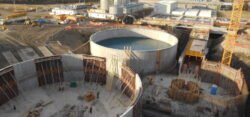City Of San Jose Wastewater Treatment Plant

Wastewater treatment plants might not be the backbone of every conversation, but they are undoubtedly the unsung heroes in maintaining public health and environmental sustainability. The City of San Jose Wastewater Treatment Plant (SJWTP) is no exception. Situated in the heart of Silicon Valley, the SJWTP is a monument to human ingenuity and a testament to our responsibility towards environmental stewardship.
This article delves deep into the intricacies of the San Jose Wastewater Treatment Plant, exploring its history, operation, impact, and future innovations. From humble beginnings to becoming one of the largest advanced wastewater treatment plants in the United States, the SJWTP has a storied legacy worth discussing.
Historical Context
The Genesis
The origins of the SJWTP can be traced back to the early 1950s when the population of San Jose and its environs started to grow rapidly due to the post-war boom. This demographic explosion led to increased wastewater production, far beyond the capacity of the existing infrastructure.
In 1956, voters approved a bond issue to fund the construction of a wastewater treatment facility. Thus, the San Jose-Santa Clara Regional Wastewater Facility (its official name, though commonly known as the San Jose Wastewater Treatment Plant) was conceived. By March 1958, the facility had commenced operations, marking the beginning of a new chapter in the city’s bid to protect public health and the environment.
Technological Evolution
From its inception, the SJWTP recognized the need for technological innovation. Initial treatments were largely rudimentary, relying primarily on primary and secondary treatments. However, as regulatory demands and environmental awareness increased, the facility continuously adapted.
In the 1970s and 1980s, further upgrades were introduced, including tertiary filtration and nitrification. This not only improved the quality of the effluent discharged into the San Francisco Bay but also set new benchmarks for other wastewater treatment plants in the region.
The Anatomy of SJWTP
The Layout
Spread over 2,600 acres, the SJWTP is an expansive facility featuring a complex array of interconnected systems designed to treat an average of about 110 million gallons of wastewater daily. The treatment process is divided into several stages, each meticulously designed to remove contaminants from the water.
Initial Screening and Grit Removal
Wastewater enters the facility through interceptor sewers and is immediately subjected to preliminary treatments. This stage involves screening to remove large debris such as plastics, rags, and other non-biodegradable materials. Following this, the wastewater passes through grit chambers where heavier inorganic particles such as sand and gravel settle out. These preliminary steps are crucial to prevent damage to downstream equipment.
Primary Treatment
The effluent then flows into primary clarifiers. Here, the velocity of the water is reduced to allow organic solids to settle at the bottom, forming primary sludge, while oil and grease float to the surface and are skimmed off. The primary effluent, now significantly less turbid, moves on to the next stage.
Secondary Treatment
Secondary treatment primarily focuses on biological processes to degrade dissolved organic matter. The SJWTP employs activated sludge systems, where microorganisms metabolize organic contaminants. This stage comprises aeration tanks where conditions are optimized for microbial growth, followed by secondary clarifiers where the biomass is separated from the treated water.
Tertiary Treatment
To further improve effluent quality, the secondary effluent undergoes tertiary treatment. This includes filtration, where remaining suspended solids are removed, and nitrification to convert ammonia into nitrate. The plant also features advanced oxidation processes and granular activated carbon for further pollutant removal.
Disinfection
The final stage involves disinfection to ensure that pathogenic organisms are neutralized. The SJWTP employs multiple disinfection methods, including chlorination and ultraviolet (UV) treatment. The disinfected effluent is then either discharged into the San Francisco Bay or repurposed for non-potable applications such as irrigation.
Sludge Treatment and Disposal
The byproducts of the treatment process, including primary and secondary sludge, undergo further treatment through anaerobic digestion and dewatering. The stabilized biosolids are either land-applied as fertilizer or transported to landfills. The biogas produced during digestion is captured and used for energy generation, contributing to the facility’s sustainability efforts.
Environmental and Public Health Impact
Safeguarding Public Health
The SJWTP plays an indispensable role in safeguarding public health. By effectively treating domestic and industrial wastewater, the facility prevents the spread of waterborne diseases and protects the community from hazardous pollutants. The stringent disinfection protocols ensure that the effluent meets or exceeds regulatory standards, providing an additional layer of security.
Protecting the San Francisco Bay
One of the most significant environmental contributions of the SJWTP is its role in protecting the San Francisco Bay. By reducing the nutrient load, particularly nitrogen and phosphorus, the plant helps prevent eutrophication, a process that can lead to harmful algal blooms and dead zones. Moreover, the facility’s advanced treatment processes effectively remove toxic substances, thereby preserving aquatic ecosystems and supporting biodiversity.
Water Reuse and Conservation
In a region plagued by periodic droughts, water conservation is of paramount importance. The SJWTP has been at the forefront of water reuse initiatives, providing high-quality reclaimed water for various non-potable purposes. This not only reduces the demand for freshwater resources but also exemplifies a sustainable approach to wastewater management.
Community Engagement and Education
Outreach Programs
The SJWTP is deeply committed to community engagement and education. The facility regularly conducts tours for schools, colleges, and civic groups, offering an immersive look into the world of wastewater treatment. These tours aim to demystify the treatment process and highlight the importance of environmental stewardship.
Public-Private Partnerships
Recognizing the value of collaboration, the SJWTP has forged numerous public-private partnerships. These alliances focus on research and development, pilot projects, and community outreach initiatives. By leveraging the expertise and resources of various stakeholders, the facility continually drives innovation and promotes sustainable practices.
Future Innovations and Challenges
Technological Advancements
In an ever-evolving field, the SJWTP is constantly exploring new technologies to enhance treatment efficiency and environmental outcomes. Current research areas include membrane bioreactors (MBRs), advanced oxidation processes (AOPs), and nutrient recovery systems. These cutting-edge technologies promise to elevate the facility’s performance to new heights while minimizing its environmental footprint.
Renewable Energy Integration
Energy consumption is a significant operational cost for wastewater treatment plants. The SJWTP is addressing this challenge by integrating renewable energy sources into its operations. Solar panels, wind turbines, and enhanced biogas recovery systems are just some of the initiatives aimed at achieving energy neutrality. Additionally, the facility is exploring the feasibility of participating in microgrid projects to enhance energy resilience.
Regulatory Compliance
The regulatory landscape governing wastewater treatment is continually evolving. Stricter discharge permits, emerging contaminants, and climate change impacts necessitate ongoing compliance efforts. The SJWTP is proactively addressing these challenges by investing in advanced monitoring systems, staff training, and adaptive management strategies.
Climate Resilience
Climate change poses significant risks to wastewater infrastructure, including increased risks of flooding, sea-level rise, and altered precipitation patterns. The SJWTP is undertaking climate resilience assessments and implementing adaptive measures to safeguard its operations. This includes fortifying physical infrastructure, optimizing stormwater management, and integrating climate scenarios into operational planning.
Case Studies and Success Stories
Algae Bloom Control
One notable success story is the SJWTP’s contribution to controlling harmful algal blooms in the San Francisco Bay. Through advanced nutrient removal processes, the facility has significantly reduced the concentrations of nitrogen and phosphorus in its effluent. This has played a vital role in mitigating eutrophication and preserving the bay’s ecological balance.
Recycled Water Initiatives
The SJWTP’s recycled water program has been a cornerstone of its sustainability efforts. By supplying high-quality reclaimed water for landscaping, industrial processes, and agricultural irrigation, the facility has conserved millions of gallons of potable water annually. This initiative has not only promoted conservation but also raised public awareness about the value of water reuse.
Energy Efficiency Milestones
In its quest for energy efficiency, the SJWTP has achieved remarkable milestones. The installation of high-efficiency aeration systems and methane-powered cogeneration units has substantially reduced the plant’s carbon footprint. These accomplishments have garnered national recognition, earning the facility accolades for its forward-thinking approach to sustainability.
Conclusion
The City of San Jose Wastewater Treatment Plant stands as a beacon of hope and innovation in the realm of wastewater management. Through a relentless commitment to technological advancement, environmental stewardship, and community engagement, the facility has not only met but exceeded the challenges posed by urbanization and climate change.
As we look to the future, the SJWTP will undoubtedly continue to be a leader in sustainable wastewater treatment, setting new standards for operational excellence and environmental protection. It is a testament to what can be achieved when vision, ingenuity, and responsibility converge to serve the greater good.
In essence, the SJWTP is more than just a wastewater treatment facility; it is a symbol of a community’s dedication to safeguarding its natural treasures and ensuring a healthier, more sustainable future for generations to come.



